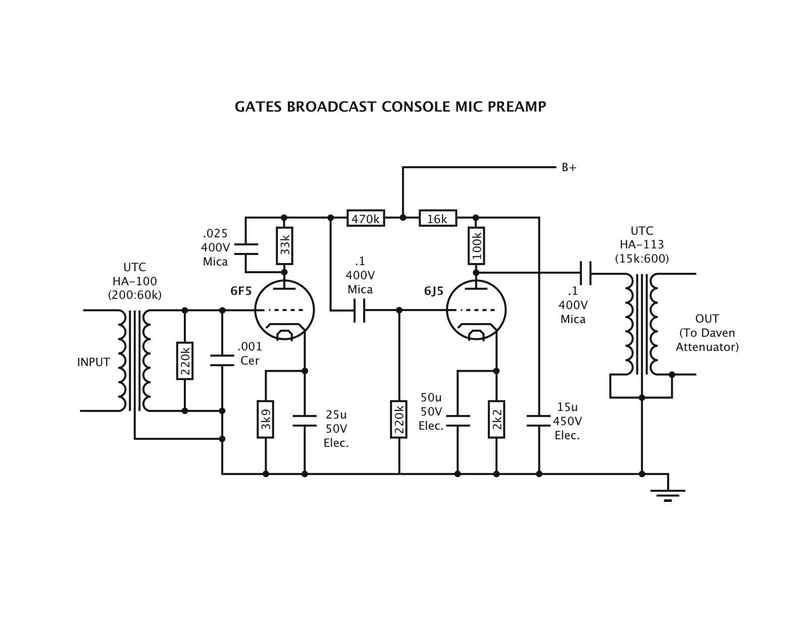rascalseven
Well-known member
I know nothing of vacuum tube circuits, but a buddy of mine has given me an old Gates tube console that is in pretty bad shape (not functioning, fairly torn apart and missing many bits, but still has most iron and tubes in it). He gave it to me on the condition that I would use the parts to rack two mic preamps for him (there are 5 preamps in it, so I can keep the other 3, plus the other bits and pieces). I figured I'd start by just learning about the stock design itself.
I combed over the mic pre's a bit and drew the following schematic from it:

Could I get some info from some of you more knowledgeable tube dudes? My questions/observations:
1) What is the total gain of this thing? It seems odd to me that there is no gain control for the mic amp itself, but only attenuation after the fact. What's to keep it from overloading with loud inputs, or do you suppose it was only intended for low output ribbon mics, etc.? The mic input (screw terminals) goes directly to the input transformer, so no ability to attenuate beforehand.
2) What is the simplest (best?) way to add continuous gain control to this? Feedback? No? (I'd like some color, but not gnarly).
3) I figure I'd add a pad before the input trafo for loud signals. Maybe stepped pad.
4) I've seen similar preamp designs but with the B+ coming in through primary winding in output transformer. I don't believe the HA-113 can handle DC, so this won't work, but for the sake of curiosity, which method is better, and why?
5) What B+ voltage do you recommend, and why? The psu was apparently outboard as there is certainly nothing inside the console, and there are screw terminals for "6.3" and "B+" on the bottom of the thing that feed the circuit.
6) Can anyone recommend a good psu design to power 2 to 3 channels of this?
7) Both tubes are the metal / octal socket versions, and the shell (pin 1) is grounded on both.
Pretty much anything you guys can throw at me will be great -- comments, corrections, suggestions, whatever. I'm definitely on a learning curve with tube stuff, so it's all welcome. I really just want to make him (and myself) some nice, usable tube preamps, preferably with a little gorgeous tube/transformer color.
Thanks!
JC
I combed over the mic pre's a bit and drew the following schematic from it:

Could I get some info from some of you more knowledgeable tube dudes? My questions/observations:
1) What is the total gain of this thing? It seems odd to me that there is no gain control for the mic amp itself, but only attenuation after the fact. What's to keep it from overloading with loud inputs, or do you suppose it was only intended for low output ribbon mics, etc.? The mic input (screw terminals) goes directly to the input transformer, so no ability to attenuate beforehand.
2) What is the simplest (best?) way to add continuous gain control to this? Feedback? No? (I'd like some color, but not gnarly).
3) I figure I'd add a pad before the input trafo for loud signals. Maybe stepped pad.
4) I've seen similar preamp designs but with the B+ coming in through primary winding in output transformer. I don't believe the HA-113 can handle DC, so this won't work, but for the sake of curiosity, which method is better, and why?
5) What B+ voltage do you recommend, and why? The psu was apparently outboard as there is certainly nothing inside the console, and there are screw terminals for "6.3" and "B+" on the bottom of the thing that feed the circuit.
6) Can anyone recommend a good psu design to power 2 to 3 channels of this?
7) Both tubes are the metal / octal socket versions, and the shell (pin 1) is grounded on both.
Pretty much anything you guys can throw at me will be great -- comments, corrections, suggestions, whatever. I'm definitely on a learning curve with tube stuff, so it's all welcome. I really just want to make him (and myself) some nice, usable tube preamps, preferably with a little gorgeous tube/transformer color.
Thanks!
JC


